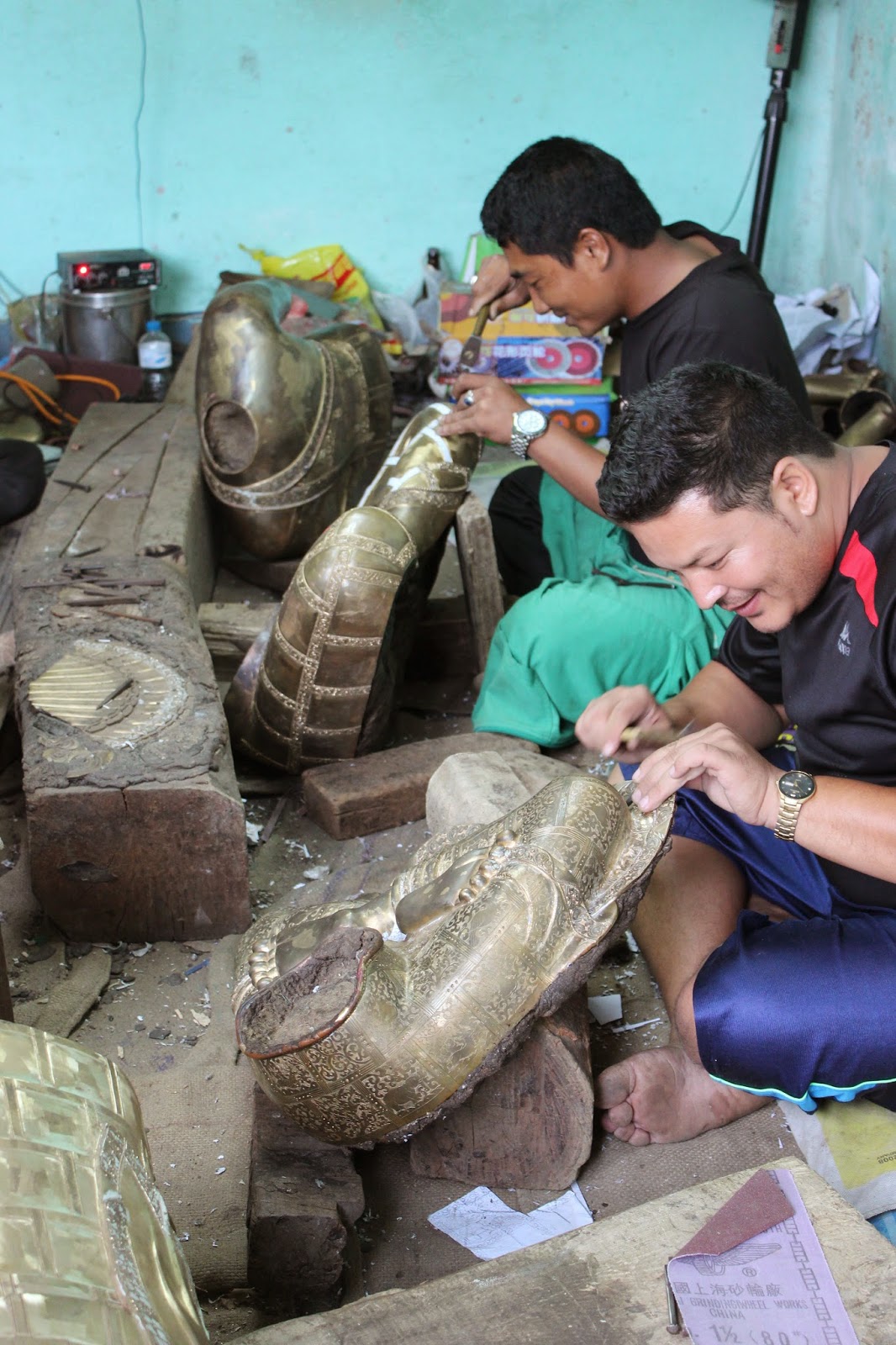The rich tapestry of beliefs, religion, ethnicity and other
social groupings which make up Napal’s culture have given the breath of life to
a huge number of crafts. Many of the villages in the Kathmandu valley are home
to members of the Newari ethnic group. Bungamati, our first
village homestay, is one such village. Here wood carvers keep their craft alive producing panels,
door and window frames which adorn their traditional houses, both in the
villages and throughout Nepal. Production of these requires an ability to create perfect repetition, that still bears the hallmarks of handcrafting at the same time begging the question – ‘was that made with a machine?’

 |
| A wood carver fashions decorative edges for panels |
 |
| Centre door panel |
 |
| Proud owner protects her carved doors |
 |
| The Nepali's answer to stained glass. |
Camphor is a popular wood to carve, but like most of their
hardwood materials it does not grow locally but instead is hauled up from the
Terai, the area of Nepal that borders India. Tools are simple but skill and
patience are boundless resulting in the creation of these artefacts. Almost
life-size likenesses of Hindu gods can take months to complete, and as we
discovered an increasing number are ending up in the homes of the European upper
classes.
 |
| Camphor is used for many stautues |
 |
| What a masterpiece of skill! |
 |
| A great viewpoint for a passing festival parade. |
Most workshops are on the ground floor of the popular 4/5
storey dwellings. It seems that each house has another workshop, engaged
in another craft. I’ve always wondered if the huge brass statues that decorate the shrines and temples are cast
solid or created from sheet metal. Now the secret is out---its sheet metal.
Created in a converted lock-up a few men using nothing more than tin snips, a
mini disc grinder and a few hammers and punches were creating the most
fantastic statues.
 |
| Making metal statues, no hi-tec. kit here |
 |
| Who said you cannot make something out of nothing. |
As my own origins are in the north west of England, where
there is a rich heritage of textiles I was intrigued to see women spinning
sheep’s wool using the simplest of devices. The graceful movement of the arms
and delicate tugs from the fingers turn clouds of natural fibre into the raw
material of the carpet maker. Once the wool is spun and transferred into
skanes of yarn, they are stained with natural dyes such as pomegranate, before
being sold on to a weaver and of course its all within the same village.
 |
| The ancient craft of wool spinning |
 |
| Spun wool a raw material for carpet weavers |
 |
| The dyed wool being used |
Just a few yards away we witness the melding of old and new
technology. In another ground floor room four women are engaged in the most
ancient of crafts---wool felting. This finished textile is used in the nomadic
wastelands of Tibet as a wind and water proof base layer in the Yurt. Not
surprisingly these craftswomen were producing for another market. Smart phone
pouches were their end products, again for the export.
 |
| Felting workshop produces smart phone pouches. |
 |
| Felting in action |

After visiting a small dairy farm is Harisiddi we heard, in a
shed ajoining the house next door, what sounded like rapid machine gun fire.
That was a sound I’d heard before, with my son Nick, near army firing ranges at
Corfe Castle. On that occaision I had genuinely mistaken the sound for a lonely
woodpecker trying to drum up a mate. (my co-worker saw it as a sign that my
final marble had been well and truly been lost). So this time we were drawn nearer
to confirm our suspicions and were relieved to find not a re-enactment of Top
Gun but instead a line of weaving machines going full bore. Once again distant
memories of cotton weaving, the sound of clog irons on cobbles and voices
shouting ‘ay up lad there’s trouble at mill’ swamped my imagination. Something
stires deep down when the air is filled with that rattle of metal on metal and
the wooden shuttles fire from one side of the loom to the other. On Skye, only a
year before I had witnessed a modern version of this kit powered by a single man
peddling the loom! I enquired if the looms were made in England, quietly hoping
that the response would be ‘ why yes they were imported from an old mill in
Clitheroe, Lancashire’. That’s where the bubble was burst when we discovered
that these were indeed Indian looms, a far more realistic outcome. The owner
and his two workers were weaving delicate fabrics for the fashion industry
 |
| this small shed had about 10 working loomes. |
 |
| Cotton is transferred to bobbins |
 |
| Our smiling dairy farmer friend Krishna stands with the loom owner. |
.
As we were about to leave the Harisiddi to return to KTM we
were lucky enough to meet a group of women who were doing another local traditional
craft, weaving shoes from straw.
 |
| Shoes being woven from straw |
































No comments:
Post a Comment